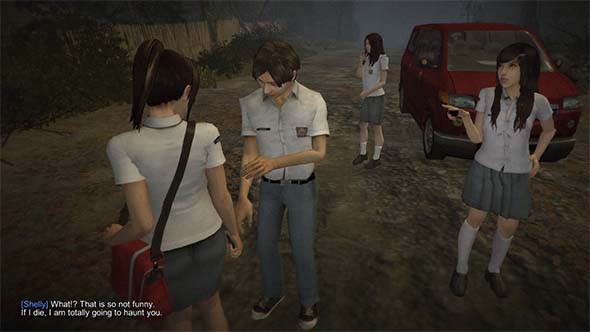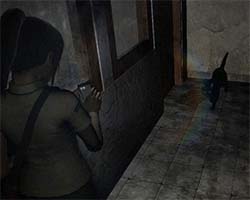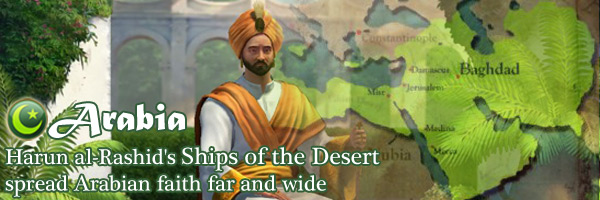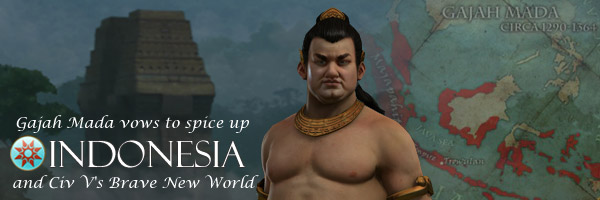
The opening moments of DreadOut set the bar pretty low for what was to come. The visual quality varies wildly. The main character, Linda, looks and animates decent enough, but the other characters all look incredibly stiff and robotic. And they sound almost as stiff and robotic. I'm not sure if it's a matter of poor translation, cultural disconnects, or if it's a deliberate attempt by the developers at camp, but the dialogue and voice acting is cringe-worthy. It wasn't even laughably bad. It was just bad. Don't worry though, you won't have to put up with them for long. They'll disappear for the majority of act 1, rendering the game's futile attempts at early character-building moot, and likely leading to you forgetting that they ever existed until they reappear later. The ghosts and monsters themselves actually get better development and depth, as each one is given a thematic backstory, and its aesthetic design attempts to represent that theme - with varying degrees of success.

Dialogue and voice-acting might have been going for deliberate camp, but ends up just being bad.
It's an indie game, so I don't expect its graphics to impress on any technical level. But what's presented on screen is often only passable for a PS2-era game, and there's very little artistry or detail in the majority of environments. Some of the environments are decent, and there's the occasional well-placed lighting or particle effect that helps to set a mood. That mood rarely lasts though, because you'll turn a corner and find repetitive environments and flat textures. It is very easy to get lost in a few areas of this game because so much of the environment looks the same. The school building was particularly bad, as all the classrooms had the same desks, chairs, and backpacks sitting around. Only two rooms in the entire building had unique decorations (a teacher's office and what appeared to be a biology lab). The difficult-to-read signposts and lack of any sort of in-game map just exacerbates the sameness of the game's environmental design.

"Aw, hello Mr. Kitty!"
Oh, you're a black cat and are
supposed to be scary. My bad..
Gameplay is less a mixed-bag, and is more universally terrible. Movement is very clunky. The camera loves to pivot around when you go through doors, leading to temporary disorientation as you try to figure out which direction the character is facing. It doesn't help that so much of the game looks the same, so it's easy to get turned around and confused (or outright lost) when the camera wigs out on you.
There's a blue vignette effect that indicates a nearby item that is designed to work as a player aid, but sometimes it can be a hindrance. It works through walls, which I guess is fine since it can let you know that you need to go into a nearby room. What isn't fine is that it also seems to work through floors and ceilings. So the game will nag you that a useful item or clue is nearby, but it might be on a different floor of the building. So you end up wandering back and forth trying to find it - which you never will because it's not there... [More]
175d6d05-3fa8-4f7e-ad1b-458c00a80c3c|4|3.5
Tags:DreadOut, Digital Happiness, horror, indie gaming, Steam, Indonesia, ghost, school girl, camera, cell phone, photograph

Continuing my series of strategy posts about Brave New World's modified civilizations, I'm going to take a look at strategies for Arabia. Arabia received a modest revision in Brave New World out of the box, having its national trait moderately redesigned. The old city connection economic focus has been regeared towards Brave New World's new trade route mechanic, and a religious buff was also added to make this civ more compelling for Gods & Kings mechanics.
The majority of the Arabian peninsula is harsh desert, and so massive human settlement did not begin until the rise of the Islamic empires of the middle ages. In the early seventh century, the Prophet Muhammad began preaching the tenets of Islam in Mecca and Medina, which united several Arabian tribes and led to the establishment of the Caliphate, an Islamic empire that began to extend its influence across the peninsula and beyond. In the mid seventh century, the Caliphate began conquering territory from the Byzantine empire and they completely destroyed the once-powerful Persian empire that had dominated the region since antiquity. At its height, the Caliphate extended from Portugal, Spain, and Morocco in the west, all the way to the borders of India in the east. Arabia's position as a crossroads between west and east made it a center for powerful trading hubs, and Arabian engineers and scientists developed advanced new mathematical concepts. Goods, knowledge, and religious beliefs from both ends of the known world (and beyond) often passed through Arabian trading bazaars, and much of the knowledge of the classical Greeks and Romans were preserved by Islamic scholars, eventually contributing to the European Renaissance centuries later.

Harun al-Rashid ruled during the mid eighth century during the Caliphate's golden age. He has been strongly romanticized by Arabian authors and scholars, and has even been mythologized in tales included in the Book of One Thousand and One Nights. He was known as a sharp political, intellectual, and military mind, but it is difficult to separate factual accounts from fictitious ones. Even his exact birth date is debatable. He was Caliph during one of the greatest periods of expansion of the early caliphates, but he also almost destroyed the Caliphate by dividing the empire among his sons instead of naming a single heir. This led to prolonged civil war between the sons, but the Caliphate did survive the turmoil.
[More]
91119a55-7a39-4ebe-9d91-07545ab26c34|3|5.0
Tags:Sid Meier's Civilization, Civilization V: Brave New World, Civilization V, ranged mounted unit, bazaar, Arabia, Harun al-Rashid, Ships of the Desert, Camel Archer, luxury resource, trade, trade route, caravan, cargo ship, religion, religious pressure, Religious Texts, Grand Temple, Market, Knight, Indonesia, oil, oasis, Civ-V

Continuing my series of Civilization V strategies, the third installation will cover Gajah Mada and his Indonesian "spice islands".
Indonesia is an Oceanic island nation between the Indian and Pacific oceans, north of Australia. Archaeological evidence shows that the region was inhabited by Homo Erectus, and that its primitive human occupants developed relatively advanced maritime technology, allowing them to sail across the ocean between the various islands of the Australian region as early as 42,000 years ago. Its early inhabitants took advantage of the tropical conditions to create flourishing agricultural communities and became masters of wet-field rice cultivation, as well as becoming traders and fishermen.
Much of the history of Indonesia has been shaped by maritime trade. Hinduism and Buddhism arrived in Indonesia around the seventh century through trade with India, and the Indonesian people welcomed these faiths with open arms and dedicated numerous temples (called "Candi") to the gods these religions brought with them. Islamic influences began around the thirteenth century in trade missions from the Middle East, and large portions of regional populations converted to this new religion. In the sixteenth century, Portuguese explorers brought Christianity to the islands. For the most part, the various religions in Indonesia intermixed and co-existed in relative peace and harmony. Portuguese traders quickly monopolized the trade of Indonesia's native nutmeg, cloves, and cubeb pepper. The Dutch arrived soon after and established their East India Company in the region and held tenuous control over the region until the Japanese occupation leading up to World War II. Following the war, bloody struggles for control of the nation resulted in hundreds of thousands of deaths, but democracy began to supersede authoritarian rule in the early 2000's. The Republic of Indonesia is currently the world's fourth most populous country, is the 16th largest economy in the world by GDP, and currently has dominion over 17,508 islands of the Indonesian archipelago.

Gajah Mada (the "Elephant General") was a mahapatih (or "prime minister") of the Majapahit Empire during the early fourteenth century who, according to myth, made a vow not to eat any spices until he had conquered all of the southeastern Asian archipelago and united it under the empire. Little is known of his early life, but he lead the empire to the height of its power during this time and presided over the arrival of the first Muslim traders. His legacy has made him a symbol of Indonesian national pride to this day.
Success as the Indonesian Empire in Civilization V is partially determined by the player's ability to develop an intercontinental "island" empire, which grants access to the valuable nutmeg, clove, and pepper spices that dominated trade with Colonial European powers. Indonesia is also uniquely positioned in Civilization V to benefit greatly from possessing followers of multiple religions in its cities. [More]
de556f70-5074-40f5-9d73-25977fbbe320|4|4.5
Tags:Sid Meier's Civilization, Civilization V: Brave New World, Civilization V, Indonesia, Gajah Mada, Kris, Candi, Spice Islanders, nutmeg, pepper, cloves, luxury resource, invulnerability, sneak attack, heroism, ambition, restlessness, recruitment, enemy blade, evil spirits, religion, Hinduism, Buddhism, Islam, navy, embark, Polynesia, Kamehameha, island, swordsman, garden, Civ V Fall Patch, Civ-V

In my review of the Brave New World expansion for Civilization V, I expressed some disappointment that some of the legacy civilizations didn't receive significant updates. I also complained about a few mechanical issues such as how the "warmonger" mechanic works and the value of trade routes. Well, Firaxis has released a major update to the game earlier this fall that addresses some of these complaints.

Several of the vanilla civilizations received a major overhaul. As I mentioned in my review, Germany and America seem to have been completely one-upped by the Zulu and Shoshone. Well, Germany has been given a major update, and America has received a small tweak in order to better differentiate them from the BNW successors. In addition, Japan has received a small (but significant) buff.
Germany was probably the civ that was in the most dire need of a facelift, since the Zulu leave them completely in the dust. Both civs had a huge military flavor, discounts for unit maintenance, and a unique Pikeman replacement, and the Zulu had Germany beat on all accounts. In order to differentiate the two, The Landsknechts unique unit was replaced with a new unique building, the "Hanse". [More]
d72a2b1a-ba97-4211-8b58-43b09c6b97b2|5|5.0
Tags:Civ V Fall Patch, patch, Civilization V: Brave New World, Civilization V, Sid Meier's Civilization, Civilization, Firaxis, 2K Games, expansion, PC, Steam, strategy, grand strategy, turn-based strategy, Germany, Japan, America, Zulu, Shoshone, Indonesia, tourism, tactics, trade, trade route, archaeology, culture, gold, warmonger, Landsknecht, Civilization IV, Civilization V
|

| 12 | | | | | | | 60 | | 11 | | | | | | | 55 | | 10 | | | | | | | 50 | | 09 | | | | | | | 45 | | 08 | | | | | | | 40 | | 07 | | | | | | | 35 | | 06 | | | | | | | 30 | | 05 | | | | | | | 25 | | 04 | | | | | | | 20 | | 03 | | | | | | | 15 | | 02 | | | | | | | 10 | | 01 | | | | | | | 05 |
|